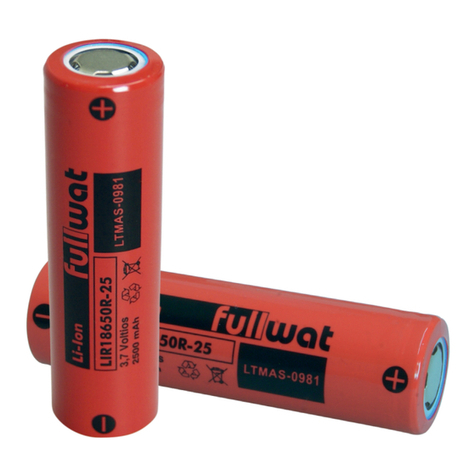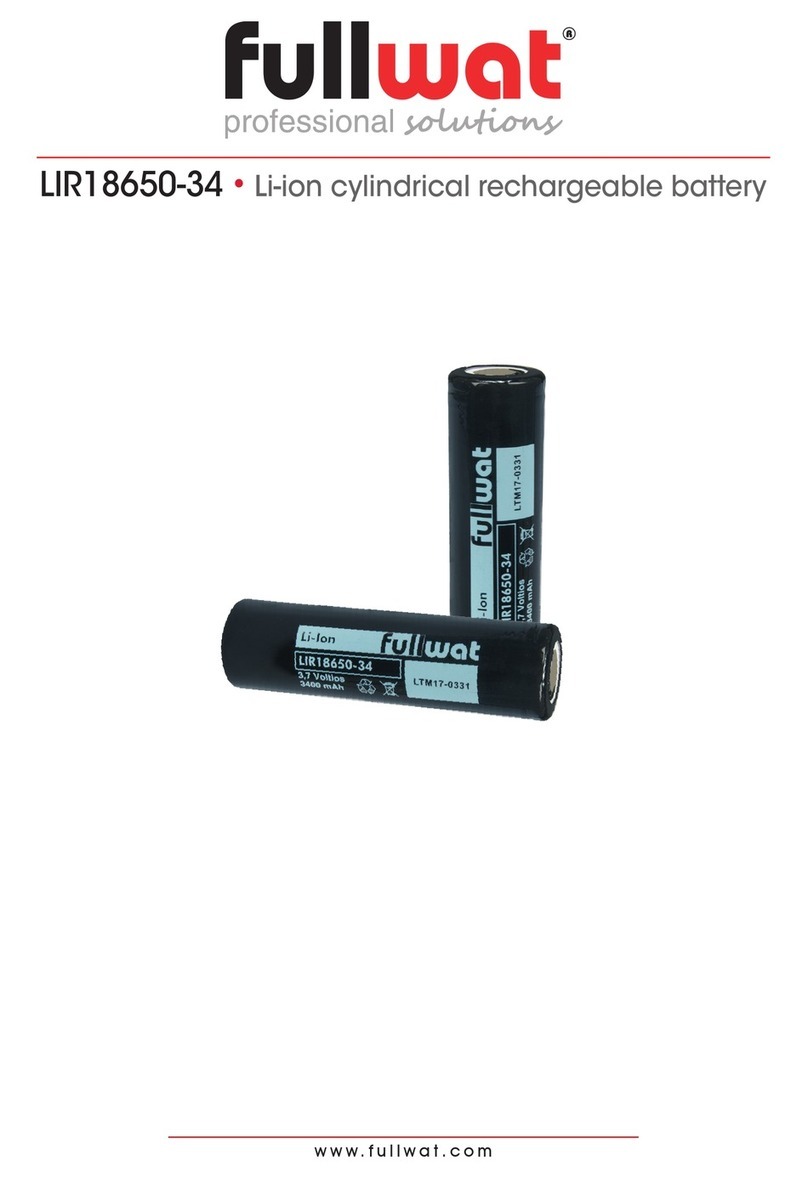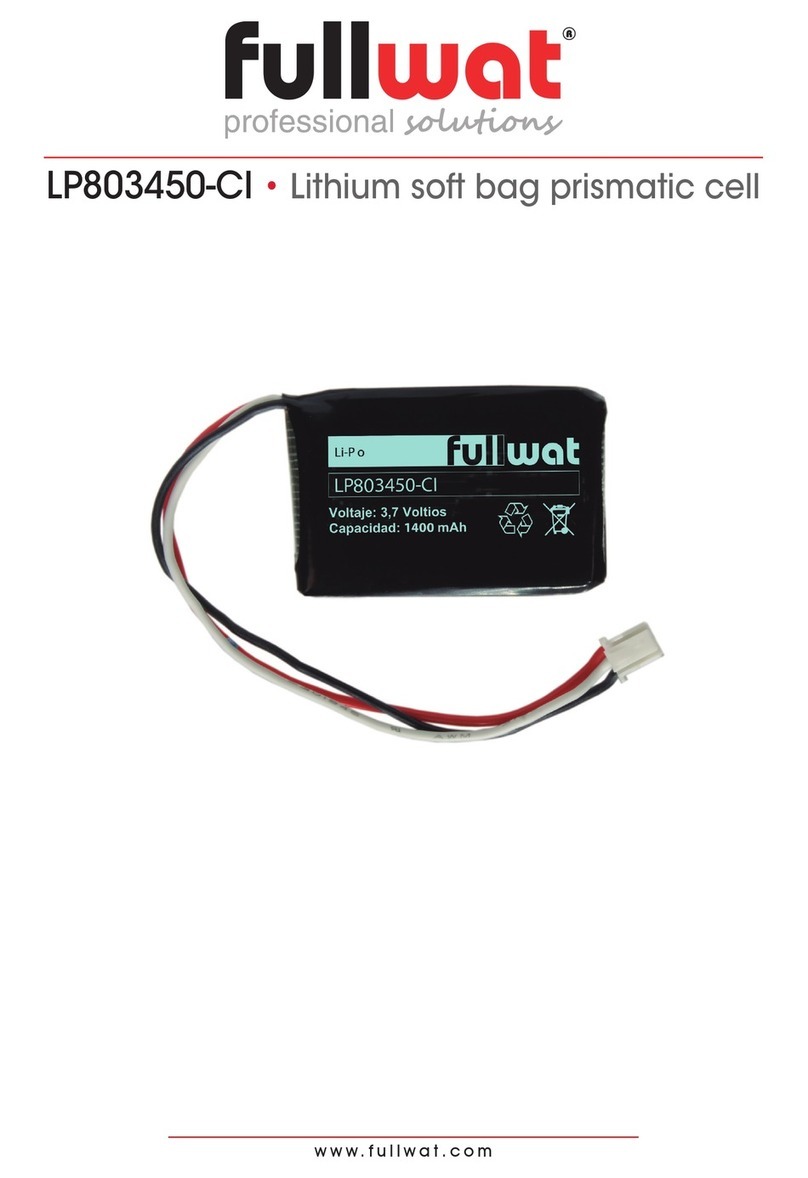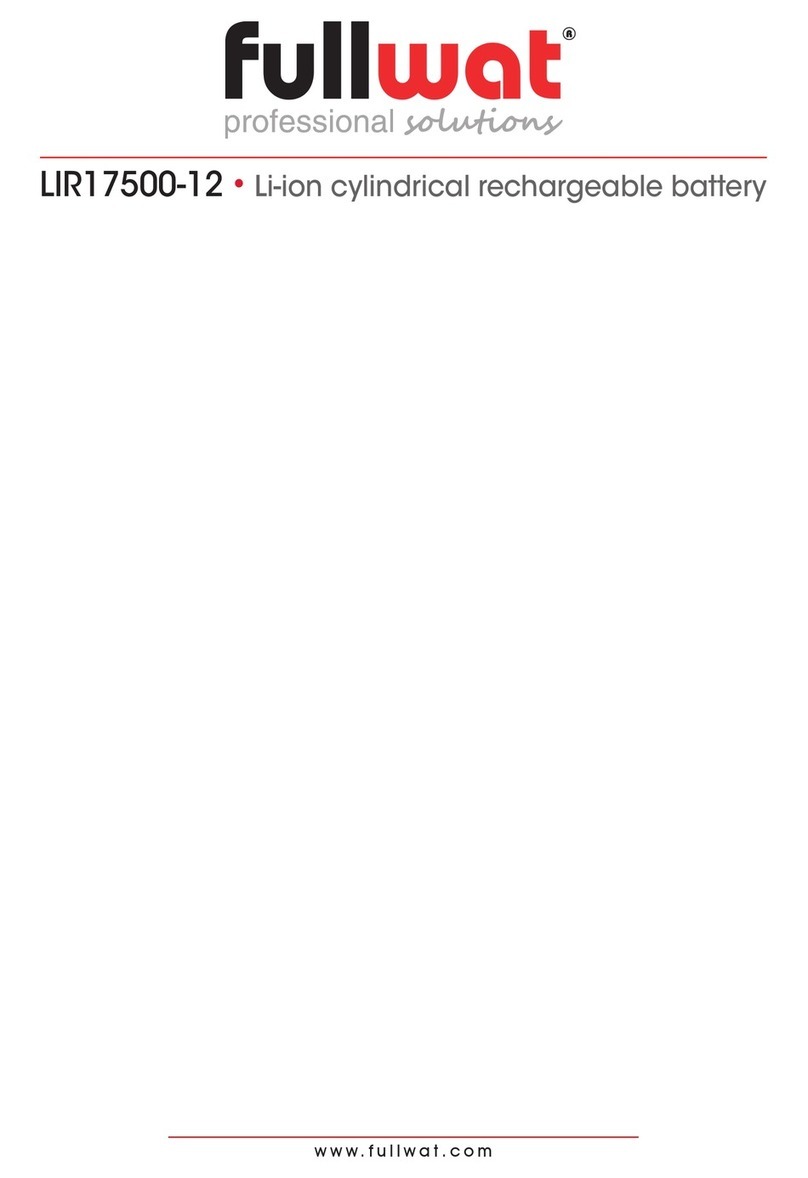
www.fullwat.com
5. Safety Test
Test conditions: The following tests must be measured air and safety protection conditions. All batteries must
standard charge and lay 24h.
LP704060-CI •Lithium soft bag prismatic cell
Item Test Methods Performance
Over charge At 20±5°C, charging batteries with constant current 3C
5
A to voltage 5V No explosion or fire
then with constant voltage 5V till current decline to 0. Stop test till
batteries temperature 10ºC lower than max temperature.
Over discharge At 20±5°C, discharge battery with 0.2C
5
A continuously 12.5h. No explosion or fire
Short circuit At 20±5°C, connect batteries anode and cathode by wire which No explosion or fire
impedance less than 50mΩ, keep 6h.
Extrusion 20±5°C, put the battery in two parallel steal broad, add pressure 13kN. No explosion or fire
Thermal shock Put the battery in the oven. The temperature of the ovenis to be raised at No explosion or fire
5±1ºC per minute to a temperature of 130±2ºC and remains 60 minutes.
6. Cautions
Cautions of batteries operation: The batteries must be careful of proceed the operation for it is soft package.
• Aluminum packing materials: The aluminum packing material was easily damaged by the sharp edge part,
such as nickel-tabs.
1. Forbid to use the sharp part touching the battery.
2. Should cleaning working condition, avoiding the sharp edge part existence.
3. Forbid to pierce the battery with nail and other sharp items.
4. The battery was forbidden with metal, such as necklace, hairpin etc in transportation and storage.
• Sealed edge:
1. Sealed edge is very easily damaged and don’t bend it.
2. The aluminum interlayer of package has good electric performance. It’s forbidden to connect with exterior
component for preventing short-circuits. (Short the anode and the aluminum interlayer of package will cause
corrosion or swollen of the cell).
• Folding edge:
1. The folding edge is formed in batteries processes and passed all hermetic test, don’t open or deform it.
2. The aluminum interlayer of package has good electric performance. It’s forbidden to connect with exterior
component for preventing short-circuits. (Short the anode and the aluminum interlayer of package will cause
corrosion or swollen of the cell).
• Tab: The cathode is aluminum tab and the anode is Nickel tab.
1. The batteries tabs are not so stubborn specially for aluminum tab. Don’t bend tabs.
2. The tab-tapes are used to isolute. The anode/cathode tabs from aluminum packing materials to prevent
short-circuit, so prohibit manicuring of the tab-tapes.
• Mechanical shock:
1. Don’t fall, hit, bent the batteries body.
2. Don’t knock on by sinker or trample the batteries.
3. Don’t sling the batteries.
• Short circuit: Short circuit is strictly prohibited. It should damage batteries badly.
1. Don’t connect the anode and cathode of the batteries to avoid short-circuit.
2. Prohibit short-circuit of the anode (or cathode) and aluminum layer of aluminum packing materials.
Standard test environment for polymer lithium-ion batteries:
• Environment temperature:
1. 20±5°C
• Humidity:
1. 45~85%
Cautions of charge and discharge:
• Charge: Charging current should be lower than values that recommended below. Higher current and voltage
charging may cause damage to cell electrical, mechanical, safety performance and could lead heat generation
or leakage.
1. Batteries charger should charging with constant current and constant voltage mode.
2. Charging current should be lower than (or equal to) 1C
5
A.
3. Temperature 0~45ºC is preferred when charging.
4. Charging voltage must be lower than 4.25V.
• Discharge:
1. Discharging current must be lower than (or equal to) 2C
5
A.
2. Temperature -10~60ºC is preferred when discharging.
3. Discharging voltage must not be lower than 2.75V.
• Over discharge: It should be noted than the cell would be at an over-discharge state by its shelf-discharge. In
order to prevent over-discharge, the cell shall be charged periodically to keeping voltage between 3.6-3.9V.
Over-discharge may cause loss of the cell performance. It should be noted that the cell would not discharge till
voltage lower than 2.75V.
Storage of polymer lithium-ion batteries:
The battery should be stored with 40-60% charge state.
The environment of-long time storage.
Temperature: 20±5°C.
Humidity: 45-85%.
Batteries were 40~60% charged.
The battery had better charge a time per three month during its storage for avoiding over discharge.
Please charge the battery with constant current 0.5C
5
A for 1 hour once every three month when is storage so that it
has some storage of charge for properly using.
Charge and discharge afresh to active and renew battery energy after storage above 1 year.
Transportation of polymer lithium-ion batteries:
The batteries must be transported with 10~50% charged states.
Others:
Please note cautions bellow to prevent cells leakage, heat generation and explosion.
1. Prohibit disassembled cells.
2. Prohibit immerse cells into liquid such as water or seawater.
3. Prohibit dumping the battery into fire.
4. Prohibit soldering directly the battery.
5. Prohibit charging the battery near fire or in the hot circumstance.
6. Prohibit place the battery in a microwave oven or pressurized container.
7. Prohibit use or store the battery where is exposed to extremely hot, such as under window of a car in directly
sunlight in a hot day. Otherwise, the battery may be overheated. This can also reduce battery performance
and/or shorten service life.
8. If the battery leaks and electrolyte gets in your eyes, don’t rub them. Instead, rinse them with clean running
water and immediately seek medical attention. If left as is, electrolyte can cause eye injury.
9. Prohibit using the battery if it gives off an odor, generates heat, becomes discolored or reformed, or appears
abnormal in any way. If the battery is in use or being recharged, remove it from the device or charger
immediately and discontinue use. If the battery leaks or gives off an odor, move it away from a fire source to
avoid fire or explosion.
7. Cell Packing and Fixing
Notice of designing battery pack: Battery pack should have sufficient strength and battery should be protected
from mechanical shock. No sharp edge components should be inside the pack contain the battery.
PCM design:
The overcharge threshold voltage should not be exceed 4.25V.
The over-discharge threshold voltage should not be lower than 2.3V.
The PCM should have short protection function built inside.
Cell connection:
Ultrasonic welding or spot welding is recommended to connect battery with PCM or other parts.
If apply manual solder method to connect tab with PCM, the notice bellow is very important to ensure battery
performance.
1. The electric iron should be temperature controlled and ESD safe.
2. Soldering temperature should not exceed 350ºC.
3. Soldering time should not be longer than 3s, keep battery tab cold down before next soldering.
4. Soldering times should not exceed 5 times.
5. Soldering spot location should be away from the tab film to ensure the sealing of the tab film.
6. The soldering spot should be smooth should be no acumination.
Cell fixing:
The battery should be fixed to the battery pack by its large surface area. No cell movement in the battery pack
should be allowed.
Cell replacement:
The cell replacement should be done by professional people.
8. Warranty
The warranty is specified in our warranties section of Terms of Sales. If the product is to be stored for more than
three months it is necessary to perform the appropriate maintenance to ensure the good condition of the batteries.
Consult our annex to the Terms of Sales on the recommended maintenance.





























